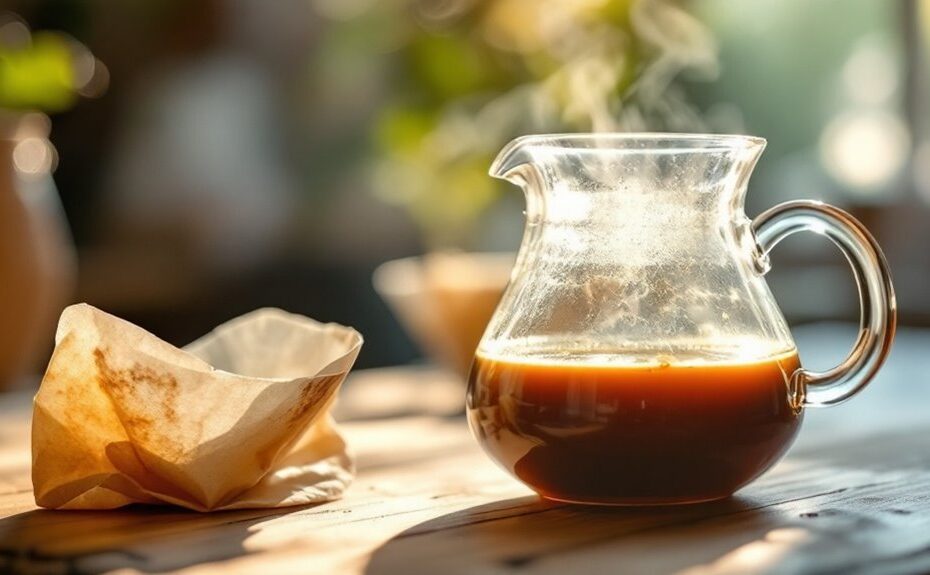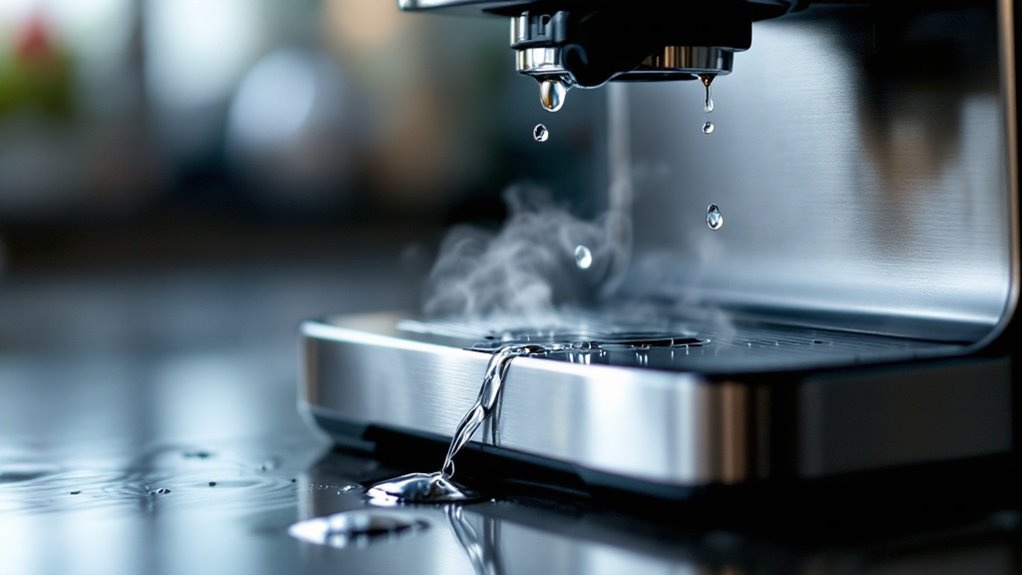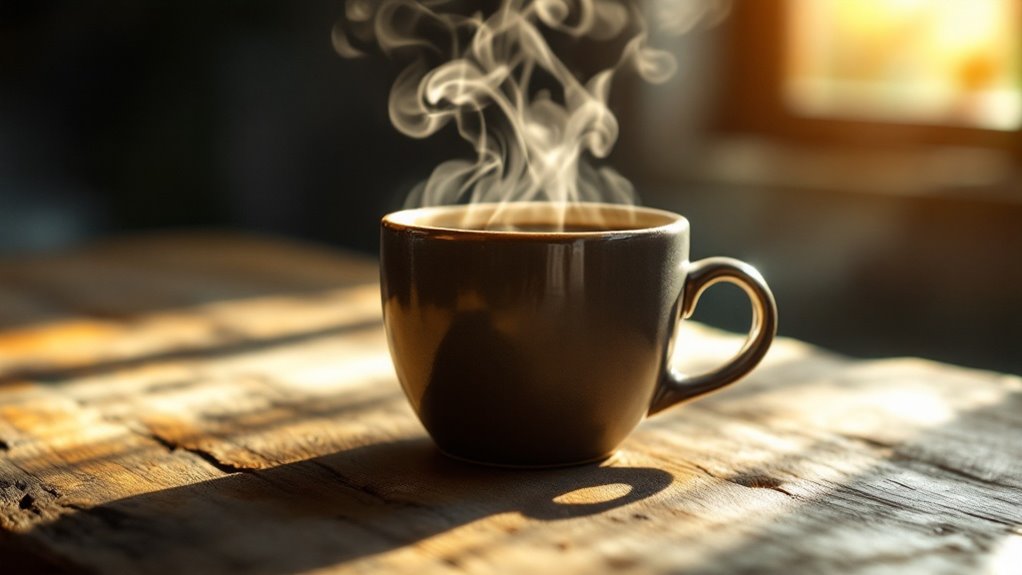







Did you know that 68% of coffee drinkers admit to struggling with weak or underwhelming coffee at least once a week? If your brew tastes more like water than a bold, flavorful cup, it's likely due to one of several common mistakes. You might be using too few grounds, brewing for too short a time, or even neglecting the importance of water temperature. But what if the issue lies deeper, in your equipment or the grind size you've chosen? Uncover the subtle factors that could be sabotaging your morning ritual and learn how to fix them.
Key Takeaways
- Using too little coffee grounds results in weak, watery coffee due to under-dosing and insufficient extraction.
- Shortened brewing times cause under-extraction, leading to weak coffee; follow recommended steeping durations for your brewing method.
- Water temperature below 195°F (90°C) causes under-extraction, resulting in weak, sour, or watery coffee.
- Coarse grind size in drip coffee or French press can lead to under-extraction and weak coffee; adjust grind size accordingly.
- Malfunctioning equipment, like a weak heating element or clogged showerhead, can prevent proper extraction, resulting in weak coffee.
Insufficient Coffee Grounds
Using too little coffee grounds is a common mistake that can leave your brew tasting weak and watery. When you don't use enough grounds, the water over-extracts the limited coffee particles, resulting in a thin, underdeveloped flavor. The coffee-to-water ratio is critical for achieving balanced extraction. For a French press, aim for 2 tablespoons of coffee per 6 ounces of water. Automatic drip brewers, which operate at higher temperatures, typically require 1-1.5 tablespoons per 6 ounces of water to compensate for faster extraction rates. If you're using less than these amounts, you're likely under-dosing, which directly impacts the strength and body of your coffee.
To fix weak coffee, start by measuring your coffee grounds precisely. Use a kitchen scale for accuracy, as volume measurements can vary based on grind size and packing. Adjust the amount of coffee grounds incrementally until you achieve the desired strength. Remember, the coffee-to-water ratio isn't one-size-fits-all; it depends on your brewing method and personal taste preferences. By increasing the amount of coffee grounds, you'll enhance extraction, creating a richer, more flavorful cup.
Inadequate Brewing Time
If your coffee tastes weak, you might not be allowing enough brewing time for proper extraction. Ideal steeping durations vary by method: French press requires 4 minutes, drip coffee 4-6 minutes, and cold brew 12-24 hours. Shortening these times under-extracts the grounds, leaving your coffee watery and lacking depth.
Optimal Steeping Duration
For a robust and flavorful cup of coffee, the steeping duration is critical. The brewing time directly impacts the extraction of oils, acids, and soluble compounds from the coffee grounds, determining the strength and balance of your brew. In a French press, you need a steeping time of at least 4 minutes to guarantee full extraction; less than this often results in weak, under-extracted coffee. For drip coffee makers, the brewing process typically takes 4-6 minutes, depending on the grind size and machine design. Espresso requires precision, with a brewing time of 25-30 seconds to avoid watery or overly bitter results. Cold brew, on the other hand, demands a much longer steeping time—12-24 hours—to compensate for the lack of heat. Each brewing method has its ideal steeping time, and failing to time the coffee correctly can lead to inadequate flavor. Always make sure you give your coffee enough time to steep, adjusting for grind size and brewing method to achieve the perfect extraction.
Impact of Brew Time
Inadequate brew time directly undermines the extraction process, leading to weak, unbalanced coffee. When brewing coffee, the time you allocate determines how much flavor compounds dissolve from the grounds into your cup. For example, in a French press, less than 4 minutes won't extract enough oils and solubles, leaving your coffee will taste flat and underdeveloped. Similarly, drip coffee makers need 4-6 minutes to achieve proper extraction; shorter times result in a watery brew. Espresso requires 20-30 seconds; pulling shots faster yields sour, weak coffee due to insufficient contact between water and grounds. Even cold brew demands 12-24 hours of steeping; cutting this short produces a diluted, flavorless cup. For pour-over methods like the V60, aim for 2.5-4 minutes to balance strength and clarity. Always use the correct grams of coffee for your brew method and maintain the ideal temperature (195-205°F) to maximize extraction efficiency. Adjusting your brew time guarantees your roast's full flavor potential is realized, delivering a rich, satisfying cup every time.
Incorrect Water Temperature
Your water temperature must stay within 195-205°F for peak extraction; cooler water (below 195°F) results in weak, under-extracted coffee due to insufficient dissolution of coffee solids. Conversely, overheating water above 205°F can cause over-extraction, leading to bitterness that masks weak flavors. Use a thermometer to monitor and maintain the ideal range, or preheat water to guarantee consistent brewing strength.
Ideal Brewing Temperature Range
Brewing coffee at the correct temperature is essential for achieving a balanced and flavorful cup. The ideal brewing water temperature ranges between 195-205°F (90-96°C). This range guarantees proper extraction of soluble compounds from the coffee grounds, balancing acidity, sweetness, and bitterness. If you use water below 195°F, the hot water won't extract enough flavor, resulting in weak, sour, or watery coffee. Conversely, water above 205°F can over-extract, leading to bitterness and an overly strong brew.
To maintain even water temperature, preheat your equipment and use a kitchen thermometer to monitor the hot water. If you're using a drip brewer, confirm it doesn't overheat the water, as many machines exceed the ideal range. For manual methods like pour-over, let the water cool slightly after boiling before pouring it over the coffee grounds.
Using filtered water is also critical, as impurities can affect both the brewing water temperature and the final taste. By controlling the water and coffee interaction within this precise temperature range, you'll consistently produce a well-extracted, flavorful cup.
Effects of Cool Water
Using water that's too cool for brewing coffee can substantially impact the quality of your cup. When your brewing temperature falls below 195°F (90°C), it leads to under-extraction, where the water fails to dissolve enough coffee solids and oils. This results in weak coffee that lacks depth and complexity, often tasting sour or watery. Cold water, whether from tap water or hard water sources, exacerbates this issue by further reducing the solubility of coffee compounds.
To avoid watery coffee, make sure your water reaches the ideal brewing temperature range of 195-205°F (90-96°C). Use a thermometer to monitor the temperature accurately. If your water heater or kettle doesn't maintain consistent heat, preheat your water before brewing. This step guarantees the water extracts the full spectrum of flavors from your coffee grounds, preventing under-extraction.
Hard water, which contains high mineral content, can also hinder extraction even at the correct temperature. Consider using filtered water to eliminate impurities that affect brewing. By addressing these factors, you'll achieve a balanced, flavorful cup and avoid the pitfalls of weak coffee caused by cool water.
Overheating and Bitterness
When water exceeds 205°F (96°C), it can over-extract your coffee, pulling out bitter compounds like tannins and creating an unbalanced, weak brew. Overheating accelerates the extraction of undesirable compounds, leading to a bitter taste that overwhelms the coffee's natural flavors. This is especially common in automatic drip coffee machines, which often operate at temperatures above the ideal range of 195-205°F. The result is a bitter cup that lacks depth and complexity, leaving you with weak coffee that fails to satisfy.
To avoid this, monitor your water temperature closely. Use a thermometer to guarantee it stays within the best range. If your coffee machine consistently overheats, consider upgrading to a model with precise temperature control. Additionally, check the water-to-coffee ratio, as overheating can cause rapid evaporation, further diluting your brew. By maintaining the correct temperature, you'll prevent over-extraction and guarantee your coffee tastes balanced and robust, free from the bitter taste that ruins an otherwise enjoyable cup.
Incorrect Grind Size
If your coffee tastes weak, the grind size might be the culprit. The grind size of your coffee beans directly impacts extraction, which determines the strength and flavor of your brew. For drip coffee makers, a medium grind is ideal, as it allows water to flow evenly through the grounds, extracting balanced flavors. If your grind is too coarse, water passes through too quickly, resulting in under-extracted, weak coffee. Conversely, an espresso machine requires a fine grind to create resistance and guarantee proper extraction under high pressure. Using a coarse grind in an espresso machine will yield a thin, watery shot. For a French press, a coarse grind is necessary to prevent fine particles from slipping through the mesh filter, but if it's too coarse, the brew will lack depth. Make sure your coffee grinds are consistent; uneven grounds can lead to both under-extraction and over-extraction in the same batch. Adjust your grinder to a finer setting if your coffee tastes weak, but avoid going too fine, as it can clog filters or over-extract, leading to bitterness.
Roast Preference Mismatch
The roast level of your coffee beans plays a significant role in determining the strength and flavor profile of your brew. If your cup of coffee tastes watery or lacks depth, it could stem from a roast preference mismatch. Light roast coffee often highlights fruity or floral notes, which some perceive as weak compared to the bold, robust flavors of a dark roast. If you prefer a stronger, more intense cup, switching to a medium or dark roast may resolve the issue. Dark roasts are more soluble, extracting richer, chocolatey, or nutty flavors that enhance the strength of the coffee. Conversely, if you're using a light roast and finding it underwhelming, consider adjusting your brewing method to maximize extraction. Tasting coffee with different roast levels helps you identify what aligns with your palate. Experiment with medium or dark roasts to achieve a bolder, more satisfying brew. Matching your roast preference guarantees you consistently enjoy good coffee without it tasting watery or weak.
Coffee Maker Performance Issues
Several factors related to your coffee maker's performance can lead to weak coffee, even with high-quality beans and proper brewing techniques. If your machine's heating element malfunctions, it may fail to reach the ideal 195-205°F range, resulting in under-extracted coffee with a flat taste. A clogged or dirty showerhead can disrupt water distribution, causing it to bypass the ground coffee and produce a watery brew. Overheating water in some machines can lead to rapid evaporation and fast percolation, reducing contact time with the grind and weakening flavor. Additionally, a weak or inconsistent pump may fail to saturate the grounds evenly, another reason for weak coffee. To maintain your machine's performance, descale it regularly to prevent mineral buildup, which can obstruct water flow and affect temperature stability. Always make sure you're using the correct grind size for your machine, as too coarse or fine a grind can exacerbate extraction issues. By addressing these performance-related factors, you can eliminate weak coffee and achieve a balanced, flavorful cup.
Water Quality and Brewing Techniques
Water quality and brewing techniques play a significant role in determining the strength and flavor of your coffee. Hard water, rich in magnesium, can enhance earthy tones, but excessive minerals may lead to scale buildup, affecting your machine's performance. Use filtered water to eliminate impurities and guarantee a clean, balanced brew. Soft water with high bicarbonates can make low-acidity coffee taste sour, so adjust your water source accordingly.
Brewing temperature is critical; aim for 195-205°F. Water below this range causes under-extraction, resulting in weak, watery coffee. Make sure your equipment heats water adequately. Uneven water distribution during brewing also leads to under-extraction. Use a gooseneck kettle or a showerhead coffee maker to achieve even water distribution, confirming all grounds are evenly saturated.
Regular descaling is essential to prevent hard water scale buildup, which can damage your machine and alter coffee flavor. Descaling solutions or vinegar can maintain your equipment's efficiency. By optimizing water quality, maintaining proper brewing temperature, and securing even water distribution, you'll avoid weak coffee and achieve a robust, flavorful cup.
Disclosure: As an Amazon Associate, I earn from qualifying purchases.





